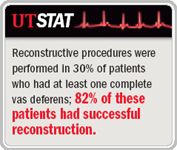Article
Surgery more accurate in finding CF-linked anomalies
Author(s):
Atlanta-Male patients who carry any of the 25 gene mutations related to cystic fibrosis (CF) may also have anomalies of the reproductive tract, including unilateral or bilateral absence of the vas deferens or epididymal obstruction.

Urologists performing surgical reconstruction or sperm retrieval to restore fertility in these patients have discovered abnormalities that differ conspicuously from those deduced through ultrasound and clinical examination. The problem is that these methods rely on genotypic and phenotypic correlations based on the American College of Medical Genetics' (ACMG) 25 mutation screening panel of the most common genetic cystic fibrosis variations.

The study reviewed surgical findings for all patients seen at the medical center fertility clinic between 2000 and 2005 and selected 67 patients, average age 34 years, who had at least one genetic mutation on a 33-51 mutation screening panel or a variant of the polythymidine tract in intron 8 (IVS8-T) on a 37-51 mutation screening panel or DNA sequencing. For these patients, genotype, surgical findings, and sperm aspiration data were correlated, and detailed surgical anatomy was retrieved from intraoperative photographs.
Fourteen different mutations of genotype or IVS8-T variants were identified. Thirty patients (44.8%) had a single mutation of genotype; 15 patients (22.4%) had a mutation of genotype and IVS8-T variant; 15 (22.4%) were carriers of IVS8-T variants only; four (5.9%) were compound heterozygotes; and three (4.5%) were homozygous carriers of IVS8-T alone. Patients found to be non-azoospermic had an average sperm density of 10.8 million/mL (range, 2-26 million/mL).
In physical examinations conducted on the 67 men, researchers found 30 patients (44.8%) with congenital bilateral absence of the vas deferens, 19 patients (28.4%) with congenital unilateral absence of the vas deferens, 13 patients (19.4%) with congenital epididymal obstruction, and five (7.5%) with varicoceles alone.
Exam results at odds
Thirty-eight of the 42 men who underwent surgery also underwent microsurgical epididymal sperm aspiration (MESA) targeting all sperm. Twenty-three men underwent vasography, nine had testicular biopsy, five had epididymovasovasostomy or vasovasostomy, three underwent transurethral resection of the ejaculatory ducts, and three underwent varicocelectomy. Of the 12 men with congenital epididymal obstruction, however, nine (75%) had segmental vasal atresia that precluded reconstruction. Reconstruction also was not possible in 11 men (57.9%) with congenital unilateral absence of the vas deferens or in any of the men with bilateral absence of the vas deferens. Reconstructive procedures were performed in 11 of 37 patients (30%) who had at least one complete vas deferens. Nine (82%) of these patients had successful reconstruction.
Analysis of MESA samples found an average volume of 0.56 mL and average density of 119 million/mL (range, 0-331 million/mL). The lowest sperm counts at surgery were found in men with compound genetic mutations. The highest sperm counts were found among the men who were heterozygous carriers of a single mutation.
"The compound mutation indicates smaller epididymal units and fewer sperm," explained Dr. Karpman. "No single mutation can predict the number of motile sperm, however."
















